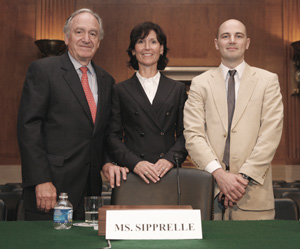By Susan M. Sipprelle
Englewood, NJ, USA
June’s unemployment rate of 9.2 percent reveals that the economy is, at best, stalled. The unemployment rate of 6.8 percent for workers over 50 looks good in comparison to the national average, but it is the highest rate ever recorded in the United States for this age group, which has reached a vulnerable point in its economic lifespan.

Susan M. Sipprelle
|
A May 2011 report published by the Center for Labor Market Studies at Northeastern University includes many shocking facts about unemployment today among older Americans. A few stand out:
- The unemployment rate for older dislocated workers is twice as high as the rate experienced by all workers when the Great Depression reached rock bottom in the 1930s.
- During the Great Recession of 2007 to 2009, one out of seven older workers in the private sector lost his or her job.
- Since the declared end of the Great Recession, older workers have been re-employed at the lowest rate in the last 30 years.
Given the U.S. budget deficit, the debt ceiling limit and impending future budget cutbacks, jobless boomers cannot expect additional assistance from government in the form of unemployment insurance, social services programs or job training. Worse yet, older workers may now also find their government jobs at risk.
During the Great Recession, workers in the private sector were more likely to lose their jobs than public sector employees, but since 2009, the situation has reversed. Almost half a million public employees have lost their jobs over the past two years. In May and June, the private sector created 130,000 new jobs, but 87,000 public sector layoffs dampened their positive impact on the overall employment rate and contributed to the economy’s morass.
“My job ends on July 29,” Sheila B., 55, of Woonsocket, R.I., wrote in an email to Over 50 and Out of Work. Sheila lost her human resources position in the banking industry during the Great Recession. After suffering through 16 months of unemployment, she was hired by a federal job training program in early 2010. When funding for that program terminates, she will be unemployed and frightened about her future once again.
On June 23, Over 50 and Out of Work testified at the Senate Health, Education, Labor and Pension committee hearing, Stories from the Kitchen Table: How Middle Class Families Are Struggling to Make Ends Meet.

Senator Tom Harkin of Iowa, Sue Sipprelle and
Sam Newman
|
We presented our testimony and showed a short video about the unemployed older Americans who have contributed to our multimedia documentary project. Ultimately, though, the experience was extremely frustrating. There was no attempt to organize the hearing along the lines we expected: here is the problem, here is the scope of the problem, here are some possible solutions, here is some data on which solutions might work, how do we head toward a workable solution?
It’s one thing to read about Washington’s dysfunctionality and another thing to be part of it, helplessly, up close and personal.
A recent New York Times story posits that the unemployed, despite numbering at least 14 million currently, have become invisible to elected officials for several reasons. First, their numbers are relatively small, compared to the number of Americans who are working, making the jobless of all ages easier for politicians to ignore. Second, the unemployed turn out to vote at a lower rate than the employed, so they do not maximize the strength of their numbers. Third, labor unions do not wield the clout they once did on behalf of workers. Fourth, most people now apply for unemployment insurance online, not at their local unemployment office, where they could easily be reached by labor organizers. Lastly, times have changed, and there are fewer labor organizers advocating for the unemployed.
What can be done?
One proposal that could help boomers, who tend to be out of work much longer than younger workers, is to create a job credit aimed specifically at the long-term unemployed. New hires would be exempted from the payroll tax paid by both the employer and the employee for as many months as the employee had been jobless. The amount of payroll tax collected by the government would decline as a result, but only for a defined period of time. According the Northeastern University report, the government is already losing more than $20,000 (in foregone taxes and transfer payments) annually and indefinitely for every unemployed older American, so some reduction in near-term payroll tax collections would be a worthwhile tradeoff to boost employment and reduce the costs of unemployment borne by government over the longer term.
It is clear, however, that the political will to reduce joblessness and its accompanying negative consequences is in short supply at every level of government. To get back to work, boomers will have to outdo and update their own activist past. They will have to mobilize online, advocate for long-run economic solutions that benefit all Americans and get out to vote at establishment-busting levels.
Link:
www.overfiftyandoutofwork.com
Susan M. Sipprelle is a multimedia documentary maker, a journalist and a photographer. She graduated from the Columbia Graduate School of Journalism in 2008, and is the mother of five children.
OVER 50 AND OUT OF WORK is an ongoing multimedia project that documents the impact of the Great Recession on jobless Americans, 50 and older. Boomers, generally regarded as self-centered and indulgent, reveal unexpected depths of faith, perseverance and resilience through their life stories.

